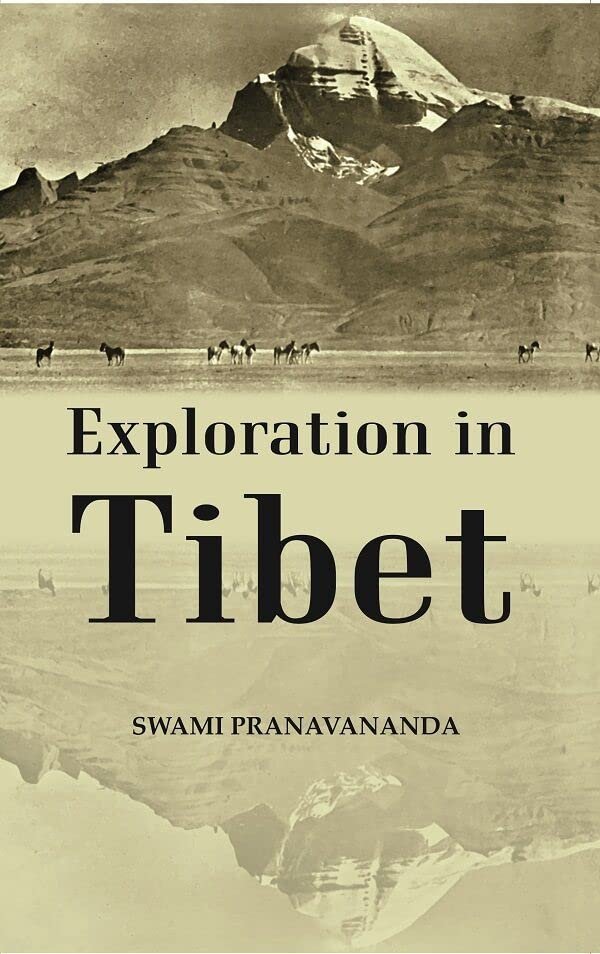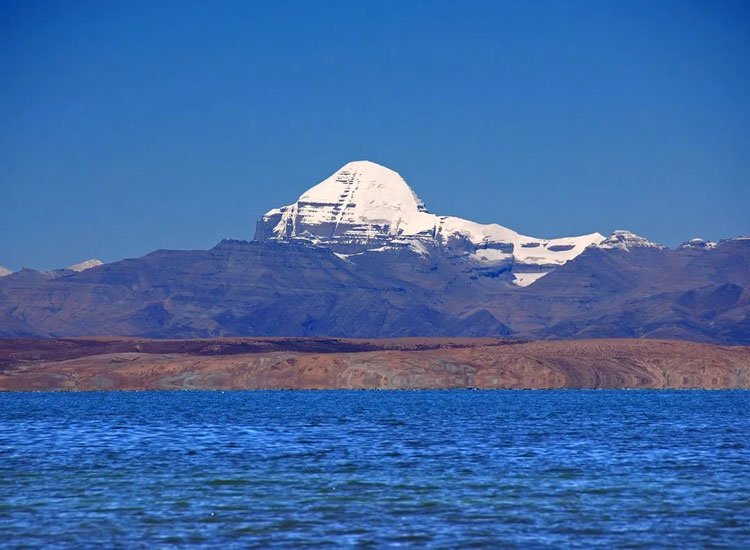
“Exploration in Tibet” by Swami Pranavananda is a captivating chronicle that delves into the uncharted territories of Tibet, capturing the essence of adventure, discovery, and cultural encounters in one of the most mystique-laden regions on the planet.Search for the truth is the noblest occupation of man; its publication is a duty.”

Swami Pranavananda also known as Yugācāryya Śrīmat Svāmī Praṇavānanda Jī Mahārāja a Hindu yogi nd saint who founded a not-for-profit and spiritual organization known as the Bharat Sevashram Sangha. He is remembered for his pioneering efforts to bring the modern Hindu society into the new age without compromising the essential values of ancient traditions of Hindu spirituality. Swamiji was one of the most influential spiritual leaders of modern India. He is still revered very much for his message of universal love, compassion for all humanity and social reform without giving up the nationalist zeal, the love of mother land.

He was born on 29 January 1896, the auspicious day of Maghi Purnima (16th Magha, 1302), in a Bengali Kayasth family Bajitpur in a village in Faridpur District in undivided India (presently in Bangladesh). His parents Vishnu Charan Bhuia and Saradadevi were very pious and blessed by Lord Shiva to have a son for the mitigation of human suffering
and universal emancipation. He was affectionately named Jaynath by his father at birth and later in his boyhood he was called Binod. Binod showed uncommon philosophical inclinations and had divine visions since childhood and often could be seen in deep contemplation at the village school. He was popular with the children of the locality because of his helpful nature .
PREFACE
“I revelled in the consciousness that except the Tibetans themselves, no other human beings but myself had penetrated to this spot Not with- out pride, but still with a feeling of humble thank- fullness , I stood there, conscious that I was the first white man who has ever penetrated to the source of the Indus and Brahmaputra. Thus declared Dr. Trans-Himalaya.”
Sven Hedin in 1908 in his Since then, the entire Geographical world believed that his was the last word on the subject of The Sources of the Four Great Rivers of the Holy Kailas and Manasarovar.’
Thirty years had elasped before it fell to the lot of a humble Indian Swami in the person of the author unaided by any of the essential modern. equipment for exploration, to find out certain dis- crepancies and errors in the findings of Sven Hedin. Herein lies the explanation for bringing out the present work; for to discover Nature’s Secrets, to realise Truth, and to disseminate knowledge are as much the duty and privilege of a spiritual aspirant as of a scientist.
maps. in incorporating the recent observations and correc- tions pointed out by the author, into the latest maps with the various insets, and for getting them pre- pared and printed for him in the Survey Office; and also to Captain C. A. K. Wilson, R.E., Photo- Litho Office for expediting the printing of the The author further tenders his love and affec- tion to his friends Messrs. A. Jogarao, M.Sc., and S. Raju, M.Sc. of the Department of Chemistry, Benares Hindu University, for helpful criticism offered and suggestions given in the pre- paration of the volume; and to Mr. Dinabandhu Ganguli, B.A., Superintendent, Calcutta University Press for having attended to the prompt publication of the book. The author’s affectionate thanks are due to Shree Bhupendra Nath Sinha, Raja Saheb of Barwari (Bhagalpur) who defrayed the major portion of the expenses for his stay on Manasarovar for a year and for his visits to the sources of the Four Great Rivers; and also to Srimans Keshab Mohan Thakur and Suraj Mohan Thakur, Zemindars of Barari Estate and to the several other friends who helped him financially and otherwise, for the undertaking of his travels to the Holy Kailas and Manasarovar region in Tibet on various occasions.
CALCUTTA,
SWAMI PRANAVANANDA August, 1939.
(of the Holy Kailas and Manasarovar)

CONTENTS
PART I
A TWELVE-MONTH ON THE HOLY KAILAS AND MANASAROVAR
Mount Kailas and Lake Manasarovar
CHAPTER I
Mount Kailas and Lake Manasarovar
Circumference – Manasarovar , monasteries, etc.-Tibetan traditions- Indian traditions-Tibetan mythology of Ganga Chhu-islands in Rakshas Tal- climate and weather conditions
CHAPTER II
Freezing of Manasarovar
Temperature readings-carly premonitions -actual freezing of the Lake-cause of fissures in the Lake-peculiar phenomena
CHAPTER III
Melting of Manasarovar
Early premonitions final breaking of the Lake contrast between the Manas and the Rakshas
Kailas-Manas Region Vegetation
CHAPTER IV
Tibet-Vegetation-jinbu-thuma
Mineral resources
CHAPTER V
Gold-fields borax, etc.-hot springs
The People
CHAPTER VI
Habitation-caves-food-dress
Custom hum-
-religion-Kanjur and Tanjur-script-
calendar-Om ma ni pad me
Similing gompa Khochar gompa Mahatmas and Tibetan mystics-swans- prasads
CHAPTER VII
Agriculture and Economic Life
Cultivation-animals, wild and domestic -sheep and wool-dairy products-trade and marts-freebooters
CHAPTER VIII
Administration
Government British Trade Agent – Zonavar Singh-Bhutanese possessions-
Currency-suggestions
Miscellaneous
Epilogue
PART II – NEW LIGHT ON THE SOURCES OF THE FOUR GREAT RIVERS
CHAPTER I
Source of the Brahmaputra.
CHAPTER II
Source of the Sutlej
CHAPTER III
Source of the Indus
CHAPTER IV
Source of the Karnali
Conclusion
I Glossary of Tibetan and other Words
II Routes to the Sources of the Four Rivers
III. Parkha to the Source of the
Sutlej at Dulchu Gompa -22 miles
- Taklakot to the Source of the Karnali at Map chaChun-
- go-23 miles
- Abstract of Mileage between
Important Places in Kailas Khanda and Kedar Khanda
- Northern View of Mount Kailas
- Sunrise on Lake Manasarovar
- Gurla Mandhata Peaks
- Raising of Tarbochhe (flag-staff) near Kailas
- Gourikund (Thuki Zingboo)
- Avalanche descending from Mount Kailas
- Southern View of Kailas Peak
- Island Lnchato
- Swans on Lachato
- Island Topserma
- Central part of Kailas-Manasarovar region, from a Tibetan painting
- The Governor of Taklakot and his Secretary
- Fissures in frozen Manasarovar
- Unfissured Ice of Rakshas Tal, seen from Lachato 64 Island towards Topserma
- Manasarovar frozen, with fissures and regular 65 blocks of ice piled up into embankments due to coastal explosions
- Irregular blocks of ice
- A Pool of water in frozen Manasarovar
- Zebra-like Deposits of Snow on southern shores 80 of Rakshas Tal
- Gukung, Cave-village near Taklakot
- Om ma ni pad me hum
- Tanka, Tibetan Coin-obverse and reverse
- Similing Gompa of Taklakot
- Gyanina Mandi
- Mount Kailas on a full-moon night
- A laptehe, with flags, streamers, mani-stones, 97
- Chema-yungdung-pu Glaciers
- Tumchok Khambab Chhorten
- Tamchok Khambab Kangri Glaciers
- Dulchu Gompa
- Kanglung Kangri Glaciers
- Chiu Hill, with Ganga Chhu flowing at its foot 1IN THE CIN OF CIES
- Singi Khambab
- Mapcha Chungo
MAPS
Various routes to the Holy Kailas and Manasarovar and the sources of the Sutlej, Indus, Brahmaputra, and Karnali with the following insets:
- A sketch of the island Lachato
- A rough sketch of the island Topserma
- How Manasarovar froze
- Fissures in Manasarovar
- How Manasarovar melted
- The region of the Manasarovar and the sources of the great Indian rivers as represented on the Ta-ch’ing map (after Dutreuil de Rhins)
- Author’s sketch of the Real Source of the Brahmaputra
- Ekai Kawaguchi’s map
The Holy Kailas and Manasarovar
